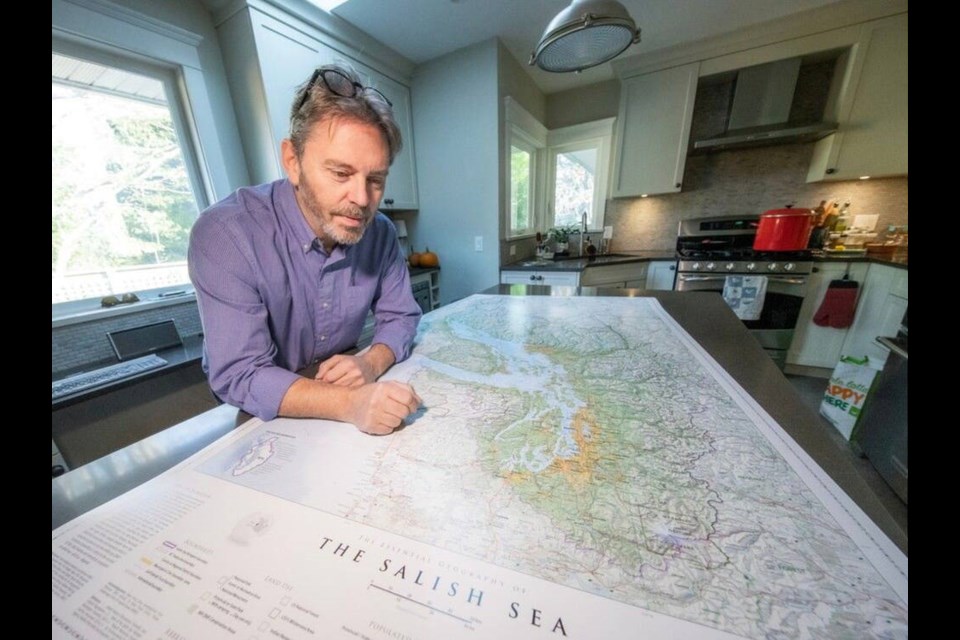Jeff Clark thought the existing maps of the Salish Sea didn’t have enough detail. So he set out to make a much more detailed map, “to increase the geographic literacy of the area.”
This meant not only showing the natural features, but also the human-made ones. And not just cities — he thought it was important to include details like the traditional lands of coastal First Nations.
The result is The Essential Geography of The Salish Sea, a wall-sized map that gives viewers a “big picture view” of the Salish Sea bioregion, which stretches from Puget Sound near Seattle to the Pantheon Mountain Range, 300 kilometres up the coast from Vancouver.
“You’ll be hard-pressed to find a map that has that kind of information on it for this kind of area, this kind of scale,” said the North Vancouver resident.
“There’s maps of the Salish Sea, but they don’t have the geographies on them. They’re straight landscape, no cities, just to give you an idea this is a bioregion. (But) we (humans) have a footprint here.
“There is a First Nations theme to it, but it’s got lighthouses, it’s got airports, where you go kayaking. We also talk about landmarks, important landmarks, it’s got provincial parks and their counterpart in Washington, the wildlife areas and state parks, their national parks.
“I even put the UNESCO biosphere regions on here. They’re big chunks of land, Howe Sound just got a new one.”
The One Earth website describes a bioregion as “a geographical area defined not by political boundaries but by ecological systems.”
The term Salish Sea was coined in the 1980s by Dr. Bert Webber of Western Washington University in Bellingham. Webber describes the Salish Sea as “an estuarine ecosystem (where) fresh water from land drainages mixes with the waters of the Pacific Ocean and results in water with a measurable, although sometimes small amount of freshwater.”
The name comes from the Coast Salish Indigenous people who lived here long before Europeans arrived. The area encompasses several bodies of water, including the Strait of Georgia, Juan de Fuca Strait and Puget Sound.
But there are boundaries to the bioregion that might surprise you. The eastern side of Vancouver Island is in the Salish Sea bioregion, but the western side is not, because water on the western side “flows directly to the ocean.”
“This area was decided by scientists and ecologists, people who are much smarter than I am in determining what’s useful and what’s not useful in a bioregion,” Clark explains.
The map comes in three sizes that sell for $60 to $100 on Clark’s online store, www.clarkgeomatics.ca.
The largest map is a giant one metre by 1.5 metres (three by five feet), which comes in handy deciphering all the details, which can be subtle. The historical “ethno-linguistic” lands of Indigenous people, for example, have light purple boundaries, with the names spelled out in all capitals.
In case you were wondering, the map wasn’t drawn by hand, it was done digitally.
“The landscape is derived from the old Space Shuttle radar topography that they captured back in the mid-80s,” he said.
“Radar altimetry it’s called. They were getting height of land based on radar that they were bouncing off the planet from the space shuttle. Crazy stuff. That data encompasses the entire planet, up to 65 north (latitude) and 65 south. It’s still used today.”
It took Clark two years to produce the map, because he isn’t a full time cartographer. His main gig is in GIS, or geographic information systems, “using location based geography and databases” to help clients “manage their information and assets.”
But the 59-year-old loves making maps.
“Between 11 p.m. and two in the morning, you can catch me doing this,” he said. “But I do need sleep.”
Sleep or not, he’s produced several folding map/guides for hikers both locally (Garibaldi, Callaghan Valley, Manning Park) and across Canada (Banff/Yoho/Kootenay parks, Algonquin Park in Ontario).
“The Banff map was included in NACIS, which is the North American Cartographic Information Society, in their atlas of design in 2018,” he said.
“It’s a prestigious award in the sense that there’s hundreds of contributors and there’s like 30 selected for the atlas.”
His hiking maps have been popular with the masses, as well as his fellow map-makers.
“Thousands sold unexpectedly over the years,” he said.
“A lot of through Mountain Equipment Co-op, a lot of it online, a lot through small stores like Valhalla and outdoor shops. They’re go-to maps … very popular with the hiking crowd.”
Clark was born in Saguenay, Quebec, and obtained a degree in geophysics from McGill University in Montreal.
“I did a dozen or so years in mineral exploration, working up in the Arctic and all over places people don’t go to,” he said. “I got out of that when (the infamous mining company) Bre-X went bust.”
He went to BCIT to obtain an advanced diploma in GIS and made that his main focus. But “off the side of the desk” he started making maps, turning a passion into a business.



